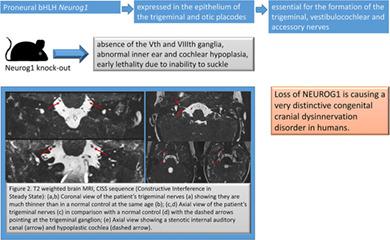当前位置:
X-MOL 学术
›
Clin. Genet.
›
论文详情
Our official English website, www.x-mol.net, welcomes your feedback! (Note: you will need to create a separate account there.)
Adding evidence to the role of NEUROG1 in congenital cranial dysinnervation disorders
Clinical Genetics ( IF 3.5 ) Pub Date : 2021-01-13 , DOI: 10.1111/cge.13922 Juliette Dupont 1 , José Pedro Vieira 2 , Ana Lisa Taylor Tavares 3, 4 , Carla Ribeiro Conceição 5 , Suliman Khan 6 , Aida Maria Bertoli-Avella 6 , Ana Berta Sousa 1, 7
Clinical Genetics ( IF 3.5 ) Pub Date : 2021-01-13 , DOI: 10.1111/cge.13922 Juliette Dupont 1 , José Pedro Vieira 2 , Ana Lisa Taylor Tavares 3, 4 , Carla Ribeiro Conceição 5 , Suliman Khan 6 , Aida Maria Bertoli-Avella 6 , Ana Berta Sousa 1, 7
Affiliation

|
Congenital cranial dysinnervation disorders (CCDDs) are a heterogeneous group of neurodevelopmental phenotypes caused by a primary disturbance of innervation due to deficient, absent, or misguided cranial nerves. Although some CCDDs genes are known, several clinical phenotypes and their aetiologies remain to be elucidated. We describe a 12‐year‐old boy with hypotonia, developmental delay, sensorineural hearing loss, and keratoconjunctivitis due to lack of corneal reflex. He had a long expressionless face, severe oromotor dysfunction, bilateral agenesis/severe hypoplasia of the VIII nerve with marked atresia of the internal auditory canals and cochlear labyrinth malformation. Trio‐exome sequencing identified a homozygous loss of function variant in the NEUROG1 gene (NM_006161.2: c.202G > T, p.Glu68*). NEUROG1 is considered a causal candidate for CCDDs based on (i) the previous report of a patient with a homozygous gene deletion and developmental delay, deafness due to absent bilateral VIII nerves, and severe oromotor dysfunction; (ii) a second patient with a homozygous NEUROG1 missense variant and corneal opacity, absent corneal reflex and intellectual disability; and (iii) the knockout mouse model phenotype which highly resembles the disorder observed in humans. Our findings support the growing compelling evidence that loss of NEUROG1 leads to a very distinctive disorder of cranial nerves development.
中文翻译:

为 NEUROG1 在先天性颅神经支配障碍中的作用增加证据
先天性颅神经支配障碍 (CCDD) 是一组异质的神经发育表型,由颅神经缺陷、缺失或误导导致的原发性神经支配障碍引起。尽管一些 CCDDs 基因是已知的,但一些临床表型及其病因仍有待阐明。我们描述了一名 12 岁男孩,因缺乏角膜反射而出现肌张力减退、发育迟缓、感觉神经性听力损失和角结膜炎。他长着一张面无表情的脸,严重的口腔运动功能障碍,双侧 VIII 神经发育不全/严重发育不全,内听道明显闭锁和耳蜗迷路畸形。三外显子组测序鉴定了NEUROG1基因中的纯合功能缺失变体(NM_006161.2:c.202G > T,p.Glu68*)。NEUROG1被认为是 CCDD 的因果候选者,基于 (i) 先前报告一名患有纯合基因缺失和发育迟缓、双侧 VIII 神经缺失导致耳聋和严重的口腔运动功能障碍的患者;(ii) 第二名患者具有纯合NEUROG1错义变异和角膜混浊、角膜反射缺失和智力障碍;(iii) 与人类观察到的疾病高度相似的敲除小鼠模型表型。我们的研究结果支持越来越多令人信服的证据,即 NEUROG1 的缺失会导致一种非常独特的颅神经发育障碍。
更新日期:2021-03-07
中文翻译:

为 NEUROG1 在先天性颅神经支配障碍中的作用增加证据
先天性颅神经支配障碍 (CCDD) 是一组异质的神经发育表型,由颅神经缺陷、缺失或误导导致的原发性神经支配障碍引起。尽管一些 CCDDs 基因是已知的,但一些临床表型及其病因仍有待阐明。我们描述了一名 12 岁男孩,因缺乏角膜反射而出现肌张力减退、发育迟缓、感觉神经性听力损失和角结膜炎。他长着一张面无表情的脸,严重的口腔运动功能障碍,双侧 VIII 神经发育不全/严重发育不全,内听道明显闭锁和耳蜗迷路畸形。三外显子组测序鉴定了NEUROG1基因中的纯合功能缺失变体(NM_006161.2:c.202G > T,p.Glu68*)。NEUROG1被认为是 CCDD 的因果候选者,基于 (i) 先前报告一名患有纯合基因缺失和发育迟缓、双侧 VIII 神经缺失导致耳聋和严重的口腔运动功能障碍的患者;(ii) 第二名患者具有纯合NEUROG1错义变异和角膜混浊、角膜反射缺失和智力障碍;(iii) 与人类观察到的疾病高度相似的敲除小鼠模型表型。我们的研究结果支持越来越多令人信服的证据,即 NEUROG1 的缺失会导致一种非常独特的颅神经发育障碍。


























 京公网安备 11010802027423号
京公网安备 11010802027423号